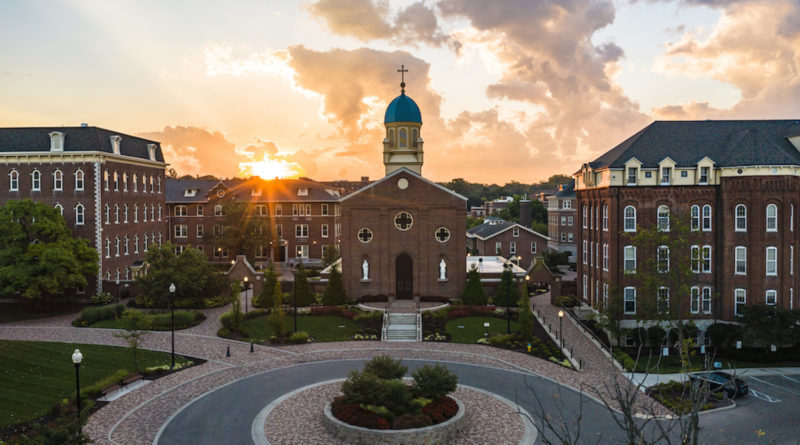A longing for community: Celebrating Mass a year into the COVID-19
Changes to traditional Mass at the Chapel of the Immaculate Conception were made to keep attendees safe this past year, but at some cost. Photo courtesy of Flyer News.
Hannah Heil | Contributing Writer
Many restrictions remain in place for Masses in the Catholic Church a year after the onset of the COVID-19 pandemic. While a limited number of people may gather in person to celebrate the Mass, restrictions prevent those gathering from feeling a true sense of community.
Father Kip Stander, University of Dayton chaplain, explains that the Catholic Church is still striving to return to normal. He describes the situation a year later as an “in-between time.”
“There is still that sense that we are not fully together,” Stander said. “We are not fully able to celebrate the Mass as we were. We are longing for the fullness.”
Many changes to Mass remain in place a year later, including limited seating, physical distancing, increased hand sanitizer use and mask wearing.
“I think the most significant change, however, is the reduced number of people attending Mass,” said Father Bob Jones, a priest in the Marianist Community and UD alum. “I have seen this not only at the UD Chapel but also at parishes where I also assist. Of course, this is due to distancing requirements and individual comfort levels.”
Masses from the Chapel of the Immaculate Conception are live-streamed for those not able to attend in person. For some students, however, there is something incomparable about celebrating Mass in person.
“Physically being in the Chapel really makes a difference, and I have noticed that for myself, too,” said Matty Spicer, a UD senior and Campus Ministry Liturgy and Chapel Student Worker. “I love seeing everyone there being able to take part in this Sacrament as a community.”
For those who continue watching Mass virtually, Stander explains that there is a longing to receive the Eucharist.
“The ability to be present at the Mass in body, soul and spirit is limited,” Stander said.
The obligation to attend Mass on Sunday was lifted at the onset of the pandemic. Many Catholic dioceses across the nation are beginning to lift the exemption from attending Mass.
“Virtual Masses were good as a quick fix during lock-down, but they will and can never replace in-person worship,” Jones said. “We believe in the Incarnation – the fact that Jesus who is fully divine also came in the flesh as fully human. We really celebrate this when we are able to gather in person.”
For those who have returned to attending Mass in-person, Jones notices less participation among the congregation.
“Another change I have seen at UD is there seems to be less participation in terms of responses,” Jones said. “It may be that the masks muffle the sound so I don’t hear as much, but it could also be a result of hesitancy due to COVID protocols.”
In some Catholic Church communities, singing is discouraged in order to reduce the spread of the coronavirus. The safety protocol has eliminated many forms of music at Mass.
“The aspect that we are one in the Lord is not there,” Stander said. “We are not able to lift up our voice as one, with everybody rejoicing and giving praise to God.”
Stander explains that he looks forward to church communities being able to add their voices and themselves to the music of the organ.
Along with less singing, fewer musical instruments are used at Mass.
“I am also looking forward to more music being introduced to Mass, not only congregational singing but also larger ensembles and other instruments for bigger celebrations,” Jones said.
Other notable changes include the restricted participation of ministers. There were typically six Eucharistic ministers who distributed the Body and Blood of Christ in the Chapel of the Immaculate Conception at Mass. Now, there is one.
Other restrictions include not being able to partake of the Blood of Christ. Catholics profess that Christ is fully present in the wine. The Catholic Church halted in offering the Chalice at Mass at the onset of the pandemic.
It will likely be a while before the Chalice will be offered at Mass and Catholics can receive the Blood of Christ again, explains Stander. With precautions, Catholics may be able to return to offering each other a sign of peace by shaking hands in the nearer future.
Even with all of the setbacks the Catholic Church has experienced, there are reasons to be optimistic. The pandemic has given people an opportunity to reflect and have greater awareness, said Stander.
“What’s the value for us as a community?” Stander poses as a question for contemplation.
For one, there is a better understanding now of the isolation many elderly citizens experience in nursing homes, UD’s Chaplain explains.
Going forward with a deeper understanding of the pain many in isolation experience, there is the anticipation of gathering together again one day in full community.
“I am really looking forward to the days where our Chapel and churches are filled with people,” Spicer said. “It will also be really nice to sit with all of our friends and be able to hug one another at the sign of peace.”
Looking forward to gathering in full community is a reminder of what the Body of Christ truly means.
“I look forward to a time when we can gather together in larger crowds without fear of contagion and when we truly celebrate together with those not in our personal ‘bubbles,’” Jones said. “There’s just something about being able to ‘rub elbows’ with each other and to remember that we are all part of the Body of Christ when we are with each other.”
For more campus news, like Flyer News on Facebook and follow us on Twitter (@FlyerNews) and Instagram (@flyernews).

